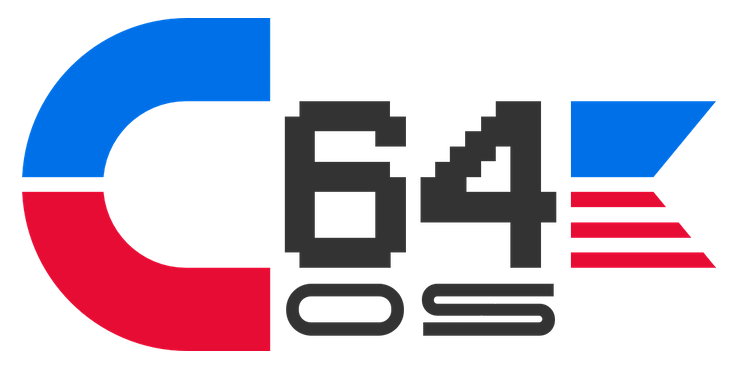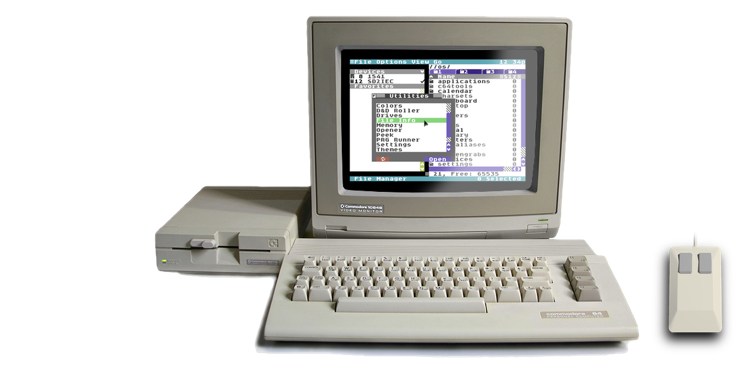Content
- Welcome Page
- Order C64 OS
- C64 OS User's Guide
- C64 OS System Updates
- Weblog Full Archive
- Commodore 8-Bit Buyer's Guide
Just as the SX-64 had its design in someway dictated by the constraints of its small 5" diagonal but very deep display, C64 Luggable is also constructed around its display.
My inspiration for building C64 Luggable came after I got hold of a black 15" LCD VGA display by Samsung. Initially I purchased a Portta S-Video to VGA adapter to be able to use the display on a desk with a C64c. But shortly thereafter I realized I had quite a few parts that could, with an achievable amount of effort, be assembled into a portable/luggable all-in-one.
For some time before I started buying any other components I played around in my head with a number of possible configurations. Until eventually I settled on the the idea of the chassis being verticle, with the motherboard mounted vertically behind the display. I started buying components before I had figured out exactly how I would mount the display in the chassis. I wanted it to be stable and secure, but I also wanted it to look sleek and minimal.
Then all of a sudden it dawned on me, the display has 4 built-in bracket mount holes on the back. The display it self is designed to be mountable. As soon as I realized that this was the way to go, I played around with a few ideas before settling on the final design.
When I came up with the design idea I ultimately went with, it just seemed obvious that I could hardly imagine it any other way. A flat plank, 1/2" thick, streched all the way across the chassis, from inside wall to inside wall, mounted with brackets and four holes drilled straight through the mount plank. It would hold the display very securely, and yet from the front and outside there would be no visible trace of how the display was attached. It's perfect.
The final width of the chassis was actually determined by the width of the display. From outer side edge to outer side edge of the side walls is exactly the width of the outermost side edges of the display. This means that if the whole chassis is lying on its back, with the display facing up, the display is resting on the front edges of the side walls of the chassis.
It didn't have to be done this way, it could have been that the outside walls extended up to be flush with the front of the display. But this would have made the whole chassis an extra 1 1/2" wide. And it would have meant that rough wood cuts would be facing the user. And it just wouldn't have looked as sleek.
The mount panel is about 5" high, which puts the holes for the mounting bolts well in from the top and bottom edges. The extra high actually comes in very handy for the motherboard mounting, described in another section of this document.
Because the display sits flush with the outsides of the side panels of the chassis, and the mount panel fits between the two side panels, the mount panel is narrower than the width of the display. The display is 14 1/2" wide, and each side panel, of HobbyBoard, is 3/4" thick. Therefore, the mount panel is (3/4" * 2) 1 1/2" less than 14 1/2". So the mount panel ends up 13" by 5". I also chose to use only 1/2" thick rather than 3/4" thick, because it's not structural, and nothing needs to screw into its side, and it saves a hair on weight and space.
When measuring out where the wholes should be drilled, it is necessary to be as precise as possible. And to drill as straight as possible. Because the bolts will pass through the 1/2" mount panel, and have to line up with the mount holes on the display with very little leeway. This is because the bolts are metal bolts, so they thread very precisely.
I used four intersecting guide lines to make sure the holes would end up in the right spots. They also helped to make sure the mount panel would end up squared with the display.
Nothing much more to drilling the holes, only to be careful to drill them as straight as possible. The side with the guidelines should end up being the side that faces the back of the display.
That worked out really well. The holes are in perfect alignment. I had to test out a variety of bolts to get the right length and thread size. I believe these were metric bolts, with flat heads. I used some washers to give a little extra surface area to the head so they can be tightened up without damaging the wood.
Also, remember, the bolts are passing straight through the wood, they're not screwing into the wood. They are metal bolts that screw into perfectly threaded holes on the back of the display. This means the display can be mounted and unmounted whenever you want without degrading or damaging the wooden mount panel.
I started playing around a bit with some L-Brackets to see how they might go on. I used thin but tall brackets. These are quite light weight, solid as a rock, and have three holes per side so they don't budge once they're screwed down.
Not only do we want the display to be the same width as the outer sides are wide, but we also want the area below the display and the plate above the display to extend out flush with the front of the display. The bottom is done that way so the display is sitting squarely on top of something, supporting it from below.
I opted to have the top plate extend out over the top of the display. This also didn't have to be this way. it could have been that the display rested against the top plate the same way it rests against the sides. And this would have brought the display up flush with the top most edge of the chassis. It would look cool, no doubt. But I also felt it would become a dust trap. As it would have left an oddly shaped upward facing gap where the curved display back meets the wood top plate. I wanted to avoid having it just fill up with dirt and dust.
I described the display notches in the side panels, earlier in this document in the section about the chassis. You can see here how the display sits nicely into those notches. With the front panel added to the front of the side walls, the thickness of the notch plus the thicness of the frontpanel add up to the thickness of the side bevel of the display. It works really well.
In these images above, the chassis has not actually been screwed together yet. Which you can tell, as there is no bottom plate there at all. It's amazing how well the chassis holds together without even being screwed together.
Seen from the bottom, through where the bottom plate would normally be, you get a really good sense of how the display fits into the chassis.
This is what I mean when I say that once I imagined how it fould together like this, there was no other way for me to imagine it. It's really perfectly convenient.
An important lesson I've learned doing this project is that it's quite difficult to make precise cuts from wood. You have to have very precise tools, the right kind of clamps and tables, a steady hand, and probably most importantly a knowledge that comes from experience working with wood about where to put your guide lines and where to cut relative to your guide lines such that you don't lose an 1/8" here and another there. I unfortunately lack that experience, and I also have been purchasing many tools specifically for this project. So I'm not spending many hundreds of dollars if I can get an adequate tool for 60$.
It's not all bad though. Because I've also discovered the value of woodfiller. Many small mistakes, such as cuts that aren't perfectly straight, as long as they're straight enough to form proper joins, can be leveled out and fixed up later on. Filling, sanding and painting will hopefully cover many small mistakes in this project.
Similarly with the display mount, I clearly didn't measure something as accurately as I should have. I actually prepared the display mount board long before I ever cut out and sized it against the chassis. My guess is that the chassis ended up being a few 1/8"'s too wide, and the mount panel a few 1/8"'s too narrow. The good news is that the mounting brackets get to play double duty as alignment brackets.
After assembling the outer chassis, which consts of the side panels and the top and bottom plates, I was ready to align the mount panel and fix it to the inside of the chassis.
I put down a couple of pieces of wood, then I put the display face down on these with its mount panel already attached. Then I laid the the chassis frame down on top of that. The extra wood beneath the monitor pushes it up and holds it as close to the chassis as it can be. There is some play between the mount panel and the sides, but this turns out to not actually be that bad.
The play let me center the display in the chassis not according to my idealized drawings but according to the actual cut and screwed together size. When the display is perfectly centered, the mount panel actually ended up being slightly off center.
This really isn't a problem, because I then put down some L-Brackets, and screwed them into place.
I actually left the mount panel uninstalled and out of the way while I did the work to install the handle and reinforce the upper plate. I also put the ventilation holes in the upper plate, and then came back and did the final attachment of the display mount panel.
You can't see it here, but once it was in place, I realized that I could also stick some L-Brackets on the front side of the mount panel add some extra stability.
Once the handle and ventilation had been installed, and the mount panel had been fixed into place, I put the display onto the mount. You can see above how the ventilation grill of the display itself is positioned directly below the ventillation holes in the upper plate.
Once again, I'm not convinced the chassis's ventillation holes are big enough. I may have to go back over them each with a larger drill bit. But I might do this after painting.
With the display mounted securely we can finally stand the case up and see how it looks. It's really starting to take shape with the display in place. A friend of mine said the design reminds him of an iMac. I take that as a compliment! I'm pretty pleased with how it's shaping up.
Last modified: Sep 20, 2022
This is a living document. The table of contents is a work in progress, and the content is only partially written. It will continue to be written as the project continues to be worked on.
Copyright © 2025 OpCoders Inc.
Commodore 64 and the Commodore Logo are registered trademarks of Commodore Business Machines, to which C64OS.com has no affiliation.
C64OS.com is powered by Ultralight Blogging Platform.
Instant SSL
